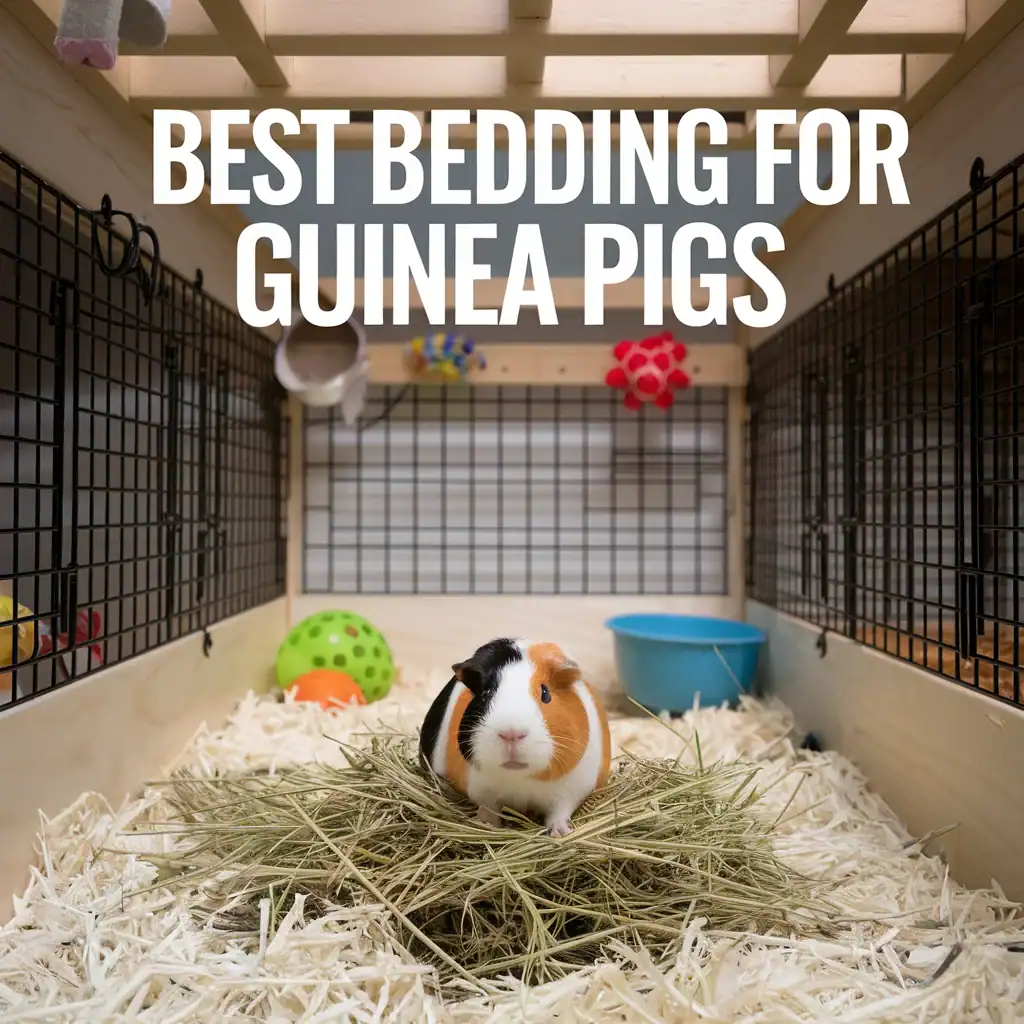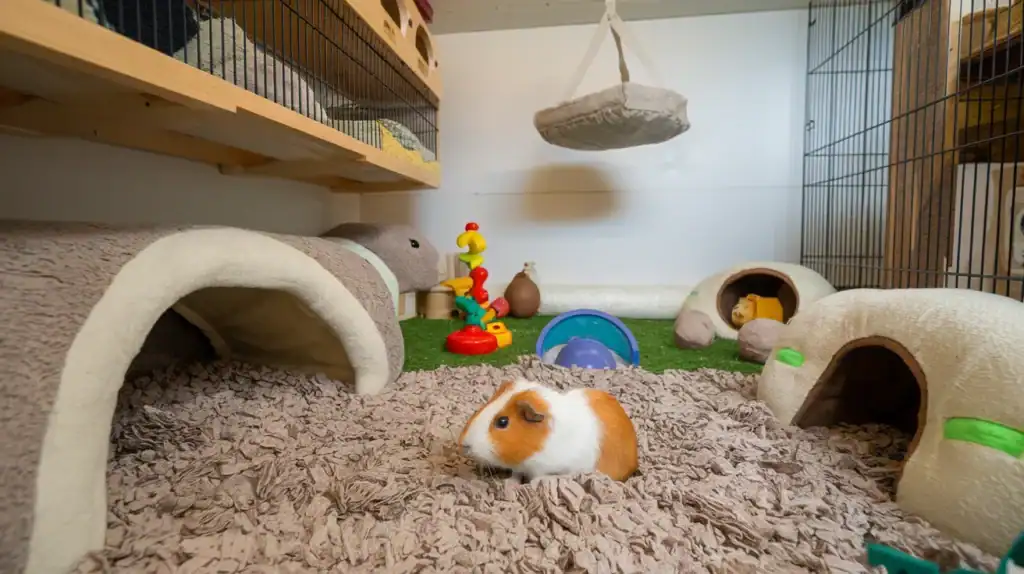When it comes to guinea pig care, one of the most important decisions you’ll make as an owner is selecting the best bedding for your pet. The right bedding not only ensures your guinea pig’s comfort but also impacts their health and well-being. In this comprehensive guide, we’ll dive deep into everything you need to know about guinea pig bedding from the factors to consider when choosing bedding to the best options available. Let’s get started!
Why Do Guinea Pigs Need Bedding?
Bedding plays a vital role in the daily life of a guinea pig. It serves multiple purposes, all of which contribute to your pet’s health and comfort.
Absorption of Urine
Guinea pigs are naturally messy animals, and their bedding must absorb urine effectively to prevent any health issues. Without absorbent bedding, urine would pool up in the cage, creating a breeding ground for bacteria and leading to potential infections, especially urinary tract infections (UTIs). So, choosing bedding that absorbs moisture quickly and thoroughly is essential for your pet’s hygiene.
Comfortable Living Space
Imagine living in a hard, uncomfortable space. Not fun, right? For guinea pigs, bedding provides a soft cushion that helps them feel at ease while they sleep, rest, or play. It also allows them to carry out their natural instinct of burrowing or nesting. Having a comfortable, cozy environment is crucial to keep your guinea pig stress-free and happy.
Hiding and Nesting
Guinea pigs are prey animals, and they need bedding that offers a sense of security. Bedding allows them to create little hideaways or nests, which helps them feel safe. The ability to hide in their bedding simulates their natural behavior and gives them a comfortable, protected space to rest.
What to Consider When Buying Guinea Pig Bedding
When shopping for guinea pig bedding, it’s important to keep several factors in mind to ensure you’re choosing the best option for your pet.
Dust-Extracted
Dust-free bedding is essential for guinea pigs, as they have sensitive respiratory systems. Dust particles can irritate their lungs and lead to breathing problems. Always opt for bedding that is dust-extracted to keep your pet’s respiratory health in top condition.
Comfortable Texture
The texture of the bedding is another key factor. Guinea pigs’ sensitive feet require bedding that is soft and gentle. Bedding that is too rough can cause sores or discomfort. Always feel the bedding before buying it to ensure it has a smooth, comfortable texture.
Unscented or Naturally Fragranced
While some bedding options come with added scents, it’s best to stick with unscented or naturally fragranced options. Strong, artificial scents can irritate guinea pigs’ noses and may even cause respiratory issues. If you prefer a bit of fragrance, look for bedding with natural, mild scents like lavender or chamomile.
Absorbency and Odour Control
Bedding that can absorb moisture and control odors is a must. Guinea pigs produce a fair amount of waste, so bedding should keep the cage dry and odor-free. High absorbency also means fewer bedding changes and a cleaner environment for your pet.
Indoor or Outdoor Guinea Pigs
Guinea pigs housed indoors may need different bedding than those kept outdoors. Indoor guinea pigs tend to stay in a more controlled environment, where you can select from a broader range of bedding. Outdoor guinea pigs, on the other hand, might need more weather-resistant bedding to handle fluctuating temperatures and humidity.
Hairless Guinea Pigs and Their Bedding Requirements
Hairless guinea pigs, like the Skinny Pig, require extra attention when it comes to bedding. Without fur to insulate them, they can get cold quickly. Choose bedding that provides additional warmth, such as fleece liners, which help keep them comfortable and cozy. Hairless guinea pigs also tend to have more sensitive skin, so bedding that’s gentle and hypoallergenic is essential.
Recommended Bedding Options for Guinea Pigs

There are many types of bedding available on the market. Here are some of the most popular and effective options for guinea pigs:
Pine Bedding
Pine bedding is one of the most common choices for guinea pigs. It’s affordable, absorbent, and provides a pleasant, natural scent. However, pine bedding should be kiln-dried to eliminate harmful aromatic oils that could irritate your guinea pig’s respiratory system.
Pros:
- Affordable and easy to find
- Natural scent
- Good absorbency
Cons:
- Can contain harmful aromatic oils if not kiln-dried
- May cause respiratory issues if not handled properly
Noodle Bath Mats
Innovative and often overlooked, noodle bath mats are great for guinea pigs. Made from a soft material, these mats are highly absorbent, easy to clean, and provide a comfortable surface for your pet. You can even add a layer of hay on top for extra comfort.
Pros:
- Easy to clean and maintain
- Highly absorbent
- Comfortable for guinea pigs’ feet
Cons:
- Needs to be washed regularly
- May not absorb as much moisture as some other options
Fleece Liners
Fleece liners are reusable bedding options that provide a soft, cozy surface for guinea pigs. They’re an eco-friendly choice since you can wash and reuse them multiple times. However, fleece liners require regular cleaning and washing to prevent urine from soaking through.
Pros:
- Eco-friendly and cost-effective over time
- Soft and comfortable
- Can be customized to fit your cage
Cons:
- Requires frequent washing
- Not as absorbent as some other materials
Aspen Bedding
Aspen bedding is a safe and natural bedding choice for guinea pigs. It’s less likely to cause respiratory issues than pine bedding and offers good absorbency. Aspen is also chemically free and safe for guinea pigs to burrow in.
Pros:
- Safe and chemical-free
- Absorbs moisture well
- Provides a comfortable environment
Cons:
- Can be more expensive than other options
- Needs to be changed frequently to prevent odor buildup
Paper Bedding
Paper bedding, made from recycled paper, is one of the most absorbent and soft options available. It’s perfect for guinea pigs with sensitive respiratory systems because it’s dust-free and hypoallergenic. Paper bedding is also great for odor control, absorbing urine and odors quickly.
Pros:
- Highly absorbent and soft
- Safe for guinea pigs with respiratory issues
- Good odor control
Cons:
- Can be more expensive
- Not as eco-friendly as some other options
Hemp Bedding
Hemp bedding is a more sustainable choice, made from the fibers of the hemp plant. It’s highly absorbent and controls odors well. It’s also more eco-friendly compared to traditional wood-based bedding.
Pros:
- Sustainable and eco-friendly
- Highly absorbent
- Excellent odor control
Cons:
- More expensive than some other options
- May not be as widely available as other types of bedding
How Much Bedding Do Guinea Pigs Need?
The amount of bedding your guinea pig needs depends on several factors, including the size of the cage, the number of guinea pigs, and how often you clean the cage.
General guidelines:
- For a single guinea pig, a layer of bedding around 1 to 2 inches deep should suffice.
- If you have multiple guinea pigs, you may need to increase the depth of the bedding to ensure it stays absorbent.
- Always ensure the bedding covers the entire floor of the cage to provide your guinea pig with a comfortable, secure environment.
How Often Should I Change My Guinea Pig’s Bedding?
To maintain a clean and hygienic environment, you should change the bedding in your guinea pig’s cage at least once a week. However, you should also spot-clean daily to remove wet bedding and waste. Regular cleaning helps prevent the buildup of bacteria, mold, and odors.
If you’re using fleece liners, you may need to wash them every 3 to 4 days, depending on how often your guinea pig uses the bathroom. For paper or hemp bedding, changing the bedding once a week is usually sufficient, though spot cleaning is always a good idea.
How to Transition From One Bedding to Another
Switching guinea pig bedding can be a bit tricky, especially if your pet is used to a certain type. Here’s a step-by-step guide to transitioning bedding:
- Gradual Transition: Start by mixing the old bedding with the new bedding. Over the course of a few days or weeks, gradually increase the amount of new bedding while decreasing the old.
- Observe Behavior: Watch how your guinea pig reacts to the new bedding. If they seem uncomfortable, give them more time to adjust.
- Maintain Cleanliness: Ensure that the cage is still kept clean during the transition. Guinea pigs can be sensitive to changes in their environment.
Bedding to Avoid
While there are many great options for guinea pig bedding, there are also some you should avoid. These types of bedding can be harmful to your guinea pig’s health.
Cedar Bedding
Cedar bedding contains oils that are toxic to guinea pigs. These oils can cause respiratory problems and skin irritation. While cedar bedding may smell pleasant, it poses a significant health risk to your pet, so it’s best to avoid it.
Clay-Based Litter
Clay-based litter, including brands like clumping cat litter, is not suitable for guinea pigs. These types of bedding can be harmful because of the dust they produce and the chemicals used in their production. The dust can cause respiratory issues, while the clumping nature can lead to ingestion hazards.
Corncob Bedding
Corncob bedding may seem like a good option, but it can easily develop mold when it gets wet. Ingestion of moldy corncob bedding can lead to serious health problems. It’s best to avoid this type of bedding.
Conclusion
Choosing the best bedding for guinea pigs is essential for their comfort, health, and happiness. Whether you choose fleece liners, paper bedding, or something else, always keep in mind that your guinea pig’s well-being depends on your decisions. Make sure the bedding is absorbent, comfortable, and safe for your pet, and remember to clean the cage regularly to maintain a hygienic environment.
With the right bedding, your guinea pig will have a comfortable, safe, and healthy home. Happy guinea pig parenting!
People Also Ask and FAQs
What is the best bedding for guinea pigs with sensitive respiratory systems?
Paper bedding and fleece liners are the best options for guinea pigs with respiratory sensitivities. Both are dust-free and hypoallergenic, making them ideal for guinea pigs that suffer from breathing issues.
Can I use cat litter for guinea pig bedding?
No, it’s not recommended to use cat litter. Cat litter can be toxic, dusty, and potentially harmful to guinea pigs. Always choose bedding that is specifically designed for guinea pigs.
What type of bedding do guinea pigs need in winter?
During winter, fleece liners or thicker bedding like hemp can help keep guinea pigs warm. Hairless guinea pigs especially need extra warmth during colder months.
How often should I clean my guinea pig’s cage?
Spot clean daily to remove wet bedding and waste, and change the bedding completely once a week to ensure your guinea pig’s environment remains clean and hygienic.
Can I use shredded newspaper as guinea pig bedding?
Shredded newspaper can work, but it’s not as absorbent as other bedding options. It’s best used in combination with other types of bedding, like fleece or paper-based options, for better absorbency.


Pingback: Best Guinea Pig Runs & Playpens Indoors & Outdoors